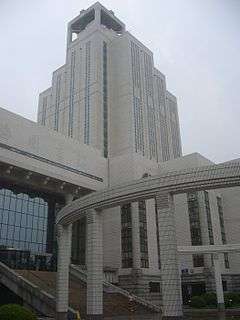Shanghai Library
The Shanghai Library (Chinese: 上海图书馆; pinyin: Shànghǎi Túshūguǎn), which also houses the Shanghai Institute of Scientific and Technological Information (Chinese: 上海科学技术情报研究所; pinyin: Shànghǎi Kēxué Jìshù Qíngbào Yánjīusǔo), is the municipal library of Shanghai, China. It is the second largest library in China after the National Library in Beijing. At 24 stories and 348 feet (106 m) tall, it is the second tallest library in the world, as well as one of the largest.[1] The building has a tower that looks like a giant lighthouse.
 | |
| Established | 1847 for Bibliotheca Zi-Ka-Wei, July 1952 for Shanghai Library |
|---|---|
| Location | Shanghai, China |
| Branches | n/a |
| Access and use | |
| Circulation | n/a |
| Population served | members of the public |
| Other information | |
| Budget | n/a |
| Director | Chen Chao |
| Staff | n/a |
| Website | http://www.library.sh.cn/english/ |
Early History: The Xujiahui (Zikawei) Library
The Bibliotheca Zi-Ka-Wei is the first modern library to have been established in Shanghai. It was established in 1847.[2]
Mergers
In 1925, Shanghai East Library, the first library run by Chinese, was opened. In 1950, the Shanghai Cultural Heritage Managing Committee launched a campaign to collect books and after about a year, the collection grew to more than 200,000 volumes. Many scholars and celebrities contributed and some of them made large donations. The committee also started to buy books from abroad. After the mission schools and scientific establishments had been taken over by the Chinese government, the last foreign Jesuits left Xujiahui in 1951.[3] The Xujiahui Library, along with other libraries formerly run by foreign groups, was placed under the control of the Shanghai Municipal Library, which had been established on July 22, 1952. This was the first large municipal public library in Shanghai. Marked the Shanghai library career in the founding of new China has taken a historic step. The library had a collection of more than 700,000 volumes. the Shanghai Municipal Library of Historical Documents(formerly known as Shanghai private Hezhong library founded in 1939 by Jingkui Ye and Yuanji Zhang), The Xujiahui Library (Bibliotheca Zikawei), which reopened in 1977, also became a branch of the Shanghai Library. It was the second largest comprehensive public library in China, in terms of collection, services, and professional expertise. In October 1995, the Shanghai library merged with the Shanghai Institute of science and technology information, and became the first provincial (city) level library and information association.[4]
Ancient books protection
Shanghai library has compiled 130 volumes of ancient books (including books about 180 thousand copies), 160 thousand (of which 2 thousand copies),the Ming and Qing Dynasties in modern letters 118 thousand. A large increase in the collection, fully illustrated by the care and support of all sectors of society, the Shanghai library for the collection and preservation of traditional cultural heritage of great importance.[5]
Library in the modern era
Shanghai Library merged with the Institute of Scientific and Technological Information of Shanghai (ISTIS) in October 1995. It became the first ever library in China that combines public library services with SciTech and industry information research functions. It is operated with a high efficient book transportation system type Telelift to handle the huge volume of books per day.
Today, it is the largest public library in China and one of the ten largest libraries in the world. It was opened to the public on December 20, 1996. It covers 3.1 hectares of land, with a floor space of 83,000 square meters.
Internet access
On the ground floor, there are three computers. Each can be accessed via reader identity card for 2 hours a day.
Location
The Library is located at 1557 Huaihai Zhong Lu, Xuhui District of Shanghai. (Address for locating the Shanghai Library Simplified Chinese: 上海市淮海中路1557号,近复兴中路)
See also
- Libraries in the People's Republic of China
- Chinese Library Classification (CLC)
- Archives in the People's Republic of China
- Pudong Library
References
- "Shanghai Library at Emporis.com". Retrieved 2009-01-15.
- "The Bibliotheca Zi-Ka-Wei (The Xujiahui Library)" (Archive). Shanghai Library. Retrieved on September 16, 2015.
- King, Gail. (1997). The Xujiahui (Zikawei) Library of Shanghai. Libraries & Culture, 32(4), (Fall, 1997), pp. 456-469, University of Texas Press.
- Zhidao.baidu.com. (2017).Shanghai library history. [online] Available at: https://zhidao.baidu.com/question/811968111217098692.html [Accessed 14 Apr. 2017].
- Library.sh.cn. (2017).The construction and arrangement of ancient books in Shanghai Library. [online] Available at: http://www.library.sh.cn/fwzn/wxxf/index.htm [Accessed 11 Mar. 2017].
Further reading
- David H. Stam, ed. (2001). International Dictionary of Library Histories. Fitzroy Dearborn. ISBN 1579582443.

